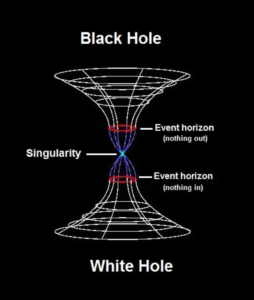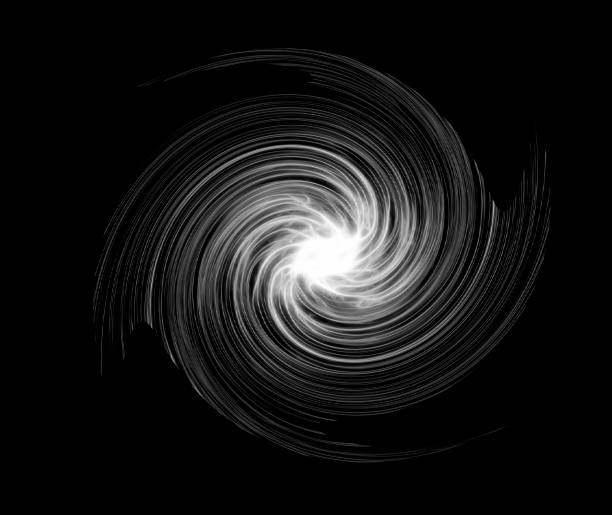Black holes are some of the most fascinating and mysterious objects in the universe. They are regions of space where gravity is so strong that nothing, not even light, can escape. But what if there were objects that were the opposite of black holes? Objects that ejected matter and energy instead of sucking them in? Scientists call these objects white holes.
They are purely theoretical objects with no observational evidence to support their existence. However, the laws of physics allow them, and some scientists speculate they might help explain certain phenomena in the universe, maintaining a balance of matter and energy.
What is a white hole?
White holes are, in essence, the theoretical opposite of black holes. While black holes are regions of space where gravity is so strong that nothing, not even light, can escape, white holes are hypothetical regions from which nothing can enter, but energy and matter can escape. In simpler terms, if black holes are cosmic vacuum cleaners, white holes are cosmic fountains, spewing out matter and light into the universe.
The concept of white holes emerges from Einstein’s theory of general relativity, the same theory that predicts the existence of black holes. However, unlike black holes, which have been indirectly observed and even photographed, they remain purely theoretical, with no observational evidence to support their existence.
The white holes concept was explored by Soviet physicist Igor Novikov in the 1960s. He, along with others, suggested that these objects could theoretically balance the equations of general relativity, maintaining the conservation of matter and energy in the universe.
How are white holes formed?

To understand white holes, we must first grasp the nature of black holes. When a massive star dies, its immense weight can cause it to collapse inward, forming a singularity – a point of infinite density and zero volume. Surrounding this singularity is the event horizon, a boundary beyond which nothing can escape the black hole’s gravitational pull.
White holes, in theory, would have similar properties, but in reverse. They would still have a singularity at their center and an event horizon at their border. However, instead of pulling matter in, they would be constantly ejecting matter and energy. Anything approaching a white hole would be repelled at speeds greater than light, making it impossible for external matter to enter.
The origin of white holes remains speculative. One captivating theory suggests they might emerge from black holes in their final stages. As black holes evaporate through Hawking radiation, they could theoretically reach a critical point where they transform into white holes, expelling the remaining energy.
Other theories propose they residing at the opposite ends of wormholes, hypothetical tunnels bridging distant spacetime regions. If wormholes exist, they might connect black holes to white holes, creating cosmic conduits. Furthermore, scientists have linked gamma-ray bursts, enigmatic explosions releasing immense energy, to white holes, although this connection is still a subject of debate.
What are the properties of white holes and it’s Relationship with Time?
Unlike their notorious counterparts, black holes, white holes exhibit a captivating phenomenon. They expel matter and energy outward at prodigious rates, impossible to recapture. This one-way passage stands in stark contrast to the insatiable appetite of black holes, where even light succumbs to their immense gravity. This fundamental difference underpins the theoretical nature of white holes, suggesting properties that mirror black holes in reverse, almost acting as cosmic rewinds.
One of the most mind-bending aspects of white holes is their relationship with time. In the mathematics of general relativity, a white hole can be thought of as a black hole running backwards in time. This time-reversal symmetry is a fascinating aspect of Einstein’s equations, but it poses significant challenges when we try to reconcile it with our understanding of how the universe actually works.
Is there any evidence for white holes?
There is no direct evidence of white holes. Theorists have them based on general relativity math but we haven’t seen them in the universe. They are the theoretical “opposite” of black holes and they are speculative. We don’t expect nature to make them observable and we mostly infer their properties from theoretical considerations. Despite the cool theoretical implications, there is no observational evidence so they are still a topic of discussion among scientists.
Challenges in proving the existence of white holes

While general relativity allows for the existence of white holes, other branches of physics, particularly thermodynamics, present significant obstacles to their existence in the real universe. The second law of thermodynamics states that the entropy (disorder) of a closed system can only increase over time. The formation of a white hole would require a decrease in entropy, which goes against this fundamental law of physics.
This thermodynamic constraint is one of the main reasons why many scientists are skeptical about the existence of white holes. Unlike black holes, which form through a well-understood process of stellar collapse, there’s no known mechanism in our universe that could lead to the formation of a white hole without violating the laws of thermodynamics.
Another challenge is the ability to observe them if they exisited. Unlike black holes, which can be observed indirectly through their effects on nearby matter, white holes would be inherently unstable. Any matter approaching a white hole would cause its event horizon to collapse, potentially transforming it into a black hole.
Quantum Effects and White Holes
Some theorists believe that a combination of Einstein’s theory of general relativity and quantum mechanics might offer a new perspective on white holes. Instead of being the exit point of a wormhole, white holes might represent a slow-motion replay of the formation of the original black hole.
In this scenario, quantum effects around the event horizon of a black hole could halt the collapse to a singularity. Instead, these effects would gradually transform the black hole into a white hole, slowly releasing the original star matter. However, this process would occur on timescales far beyond human comprehension, potentially taking longer than the current age of the universe.
Future research on white holes
Future research on white holes could help us learn more about our Universe. Scientists are working on new theories that combine quantum mechanics and general relativity to better understand white holes (Thus if they exist). Observing gravitational waves and the Cosmic Microwave Background (CMB) might give us clues about their existence.
High-resolution telescopes and space observatories could spot unusual phenomena linked to white holes. Computer simulations and experiments in quantum physics could reveal more about how white holes behave. By working together across different fields like cosmology and particle physics, researchers hope to uncover the secrets of white holes. Although we haven’t found concrete evidence yet, these studies could significantly expand our knowledge of the cosmos.
What are the implications of the existence of white holes?

The existence of white holes remains a highly speculative and theoretical concept, and there is currently no direct evidence of their existence. However, discovering them would have profound implications. These are some implications:
Challenging our understanding of gravity and spacetime
- White holes would defy the normal flow of time, as they would be the “time-reversed” version of black holes. This would challenge our conventional understanding of gravity and the behavior of spacetime.
Potential connections to wormholes
- Some theories propose that the event horizons of black holes and white holes could be connected, forming wormhole-like structures in spacetime. This could have implications for interstellar travel and exploration.
Instability and short-lived nature
- White holes are theorized to be highly unstable, as any matter approaching the event horizon would trigger the collapse of the white hole into a black hole. This suggests white holes would be short-lived phenomena.
Implications for the origin of the universe
- Some hypotheses suggest white holes could be connected to the birth of new universes, mirroring the processes associated with black holes. This raises intriguing questions about the origins of our own universe.
Difficulty in observational verification
- Despite the theoretical framework, the existence of white holes remains unverified, as there is no clear observational evidence for them in our universe. This highlights the challenges in empirically confirming these enigmatic cosmic entities.
Conclusion
White holes remain one of the most enigmatic and controversial concepts in modern astrophysics. While they emerge naturally from the mathematics of general relativity, their existence in the real universe faces significant theoretical challenges. The concept of white holes continues to inspire scientific inquiry and fuel the imagination, pushing the boundaries of our understanding of the cosmos.
As we learn more about the universe and our theories of physics evolve the status of white holes may change. For now they are a thought experiment, a reminder of how much we still don’t know about the fundamental nature of the universe. Whether white holes will ever go from theoretical curiosity to actual observation remains to be seen but the study of them continues to give us insights into space, time and the universe itself.

Thanks for sharing. I read many of your blog posts, cool, your blog is very good.